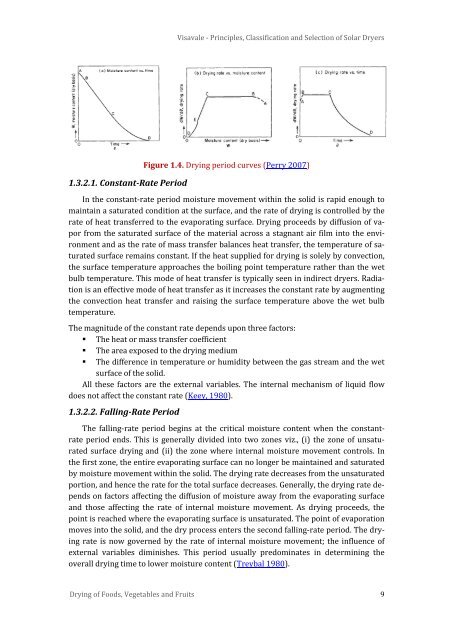Solar Drying: Fundamentals,Applications and Innovations - National ...
Solar Drying: Fundamentals,Applications and Innovations - National ...
Solar Drying: Fundamentals,Applications and Innovations - National ...
Create successful ePaper yourself
Turn your PDF publications into a flip-book with our unique Google optimized e-Paper software.
Visavale - Principles, Classification <strong>and</strong> Selection of <strong>Solar</strong> Dryers<br />
1.3.2.1. Constant-Rate Period<br />
Figure 1.4. <strong>Drying</strong> period curves (Perry 2007)<br />
In the constant-rate period moisture movement within the solid is rapid enough to<br />
maintain a saturated condition at the surface, <strong>and</strong> the rate of drying is controlled by the<br />
rate of heat transferred to the evaporating surface. <strong>Drying</strong> proceeds by diffusion of vapor<br />
from the saturated surface of the material across a stagnant air film into the environment<br />
<strong>and</strong> as the rate of mass transfer balances heat transfer, the temperature of saturated<br />
surface remains constant. If the heat supplied for drying is solely by convection,<br />
the surface temperature approaches the boiling point temperature rather than the wet<br />
bulb temperature. This mode of heat transfer is typically seen in indirect dryers. Radiation<br />
is an effective mode of heat transfer as it increases the constant rate by augmenting<br />
the convection heat transfer <strong>and</strong> raising the surface temperature above the wet bulb<br />
temperature.<br />
The magnitude of the constant rate depends upon three factors:<br />
• The heat or mass transfer coefficient<br />
• The area exposed to the drying medium<br />
• The difference in temperature or humidity between the gas stream <strong>and</strong> the wet<br />
surface of the solid.<br />
All these factors are the external variables. The internal mechanism of liquid flow<br />
does not affect the constant rate (Keey, 1980).<br />
1.3.2.2. Falling-Rate Period<br />
The falling-rate period begins at the critical moisture content when the constantrate<br />
period ends. This is generally divided into two zones viz., (i) the zone of unsaturated<br />
surface drying <strong>and</strong> (ii) the zone where internal moisture movement controls. In<br />
the first zone, the entire evaporating surface can no longer be maintained <strong>and</strong> saturated<br />
by moisture movement within the solid. The drying rate decreases from the unsaturated<br />
portion, <strong>and</strong> hence the rate for the total surface decreases. Generally, the drying rate depends<br />
on factors affecting the diffusion of moisture away from the evaporating surface<br />
<strong>and</strong> those affecting the rate of internal moisture movement. As drying proceeds, the<br />
point is reached where the evaporating surface is unsaturated. The point of evaporation<br />
moves into the solid, <strong>and</strong> the dry process enters the second falling-rate period. The drying<br />
rate is now governed by the rate of internal moisture movement; the influence of<br />
external variables diminishes. This period usually predominates in determining the<br />
overall drying time to lower moisture content (Treybal 1980).<br />
<strong>Drying</strong> of Foods, Vegetables <strong>and</strong> Fruits 9

















